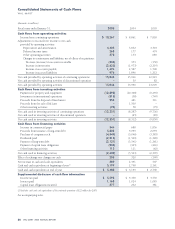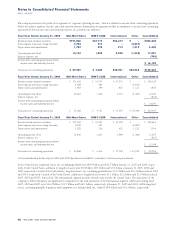Walmart 2005 Annual Report Download - page 48
Download and view the complete annual report
Please find page 48 of the 2005 Walmart annual report below. You can navigate through the pages in the report by either clicking on the pages listed below, or by using the keyword search tool below to find specific information within the annual report.
Notes to Consolidated Financial Statements
W A L -M A R T
46 WAL-MART 2005 ANNUAL REPORT
The company is a defendant in four putative class-action lawsuits,
three of which are pending in Texas, and one in Oklahoma. In each
lawsuit, the plaintiffs seek a declaratory judgment that Wal-Mart and
the other defendants who purchased Corporate-Owned Life Insurance
(“COLI”) policies lacked an insurable interest in the lives of the
employees who were insured under the policies, and seek to recover
the proceeds of the policies under theories of unjust enrichment
and constructive trust. In some of the suits, the plaintiffs assert
other causes of action, and seek punitive damages. In January 2004,
the parties to the first-filed Texas lawsuit signed a settlement agree-
ment, which received final approval from the court on October 28,
2004. The settlement will include all Texas COLI claimants who
do not opt out of the settlement class. The amount to be paid by
Wal-Mart under the settlement will not have a material impact on
the company’s financial condition or results of operations. In the
Oklahoma litigation, the court has deferred ruling on plaintiffs’
request to add 11 additional states to the litigation, pending a rul-
ing on the company’s motion for summary judgment.
The company is a defendant in Mauldin v. Wal-Mart Stores, Inc.,
a class-action lawsuit that was filed on October 16, 2001, in the
United States District Court for the Northern District of Georgia,
Atlanta Division. The class was certified on August 23, 2002. On
September 30, 2003, the court denied the company’s motion to
reconsider that ruling. The class is composed of female Wal-Mart
associates who were participants in the associates Health and
Welfare Plan at any time from March 8, 2001, to the present and
who were using prescription contraceptives. The class seeks amend-
ment of the Plan to include coverage for prescription contraceptives,
back pay for all members in the form of reimbursement of the cost
of prescription contraceptives, pre-judgment interest, and attorneys’
fees. The complaint alleges that the company’s Health Plan violates
Title VII’s prohibition against gender discrimination in that the
Health Plan’s Reproductive Systems provision does not provide
coverage for prescription contraceptives.
The company is a defendant in a lawsuit that was filed on August
24, 2001, in the United States District Court for the Eastern
District of Kentucky. EEOC (Janice Smith) v. Wal-Mart Stores, Inc. is
an action brought by the EEOC on behalf of Janice Smith and all
other females who made application or transfer requests at the
London, Kentucky, Distribution Center from 1995 to the present,
and who were not hired or transferred into the warehouse posi-
tions for which they applied. The class seeks back pay for those
females not selected for hire or transfer during the relevant time
period. The class also seeks injunctive and prospective affirmative
relief. The complaint alleges that the company based hiring deci-
sions on gender in violation of Title VII of the 1964 Civil Rights
Act as amended. The EEOC can maintain this action as a class
without certification.
9 Commitments
The company and certain of its subsidiaries have long-term leases
for stores and equipment. Rentals (including, for certain leases,
amounts applicable to taxes, insurance, maintenance, other oper-
ating expenses and contingent rentals) under operating leases and
other short-term rental arrangements were $1.2 billion, $1.1 bil-
lion, and $1.1 billion in 2005, 2004, and 2003, respectively.
Aggregate minimum annual rentals at January 31, 2005, under
non-cancelable leases are as follows (in millions):
Operating Capital
Fiscal year Leases Leases
2006 $ 730 $ 521
2007 700 514
2008 626 505
2009 578 490
2010 530 468
Thereafter 5,908 3,222
Total minimum rentals $9,072 5,720
Less estimated executory costs 42
Net minimum lease payments 5,678
Less imputed interest at rates ranging
from 4.2% to 14.0% 1,886
Present value of minimum lease payments $3,792
The company has entered into sale/leaseback transactions involv-
ing buildings and the underlying land that were accounted for as
capital and operating leases. Included in the annual maturities
schedule above are $308 million of capital leases and $32 million
of operating leases.
Certain of the company’s leases provide for the payment of
contingent rentals based on a percentage of sales. Such contingent
rentals amounted to $42 million, $46 million and $51 million
in 2005, 2004 and 2003, respectively. Substantially all of the
company’s store leases have renewal options, some of which
may trigger an escalation in rentals.
In connection with the expansion of our distribution network in
Canada, we have guaranteed specific obligations of a third-party
logistics provider. In the unlikely event this provider fails to perform
its financial obligations regarding certain Wal-Mart related projects,
we would be obligated to pay an amount of up to $118 million.
These agreements cover periods of up to 10 years.
In connection with certain debt financing, we could be liable for
early termination payments if certain unlikely events were to occur.
At January 31, 2005, the aggregate termination payment was $113
million. These arrangements expire in fiscal 2011 and fiscal 2019.
























